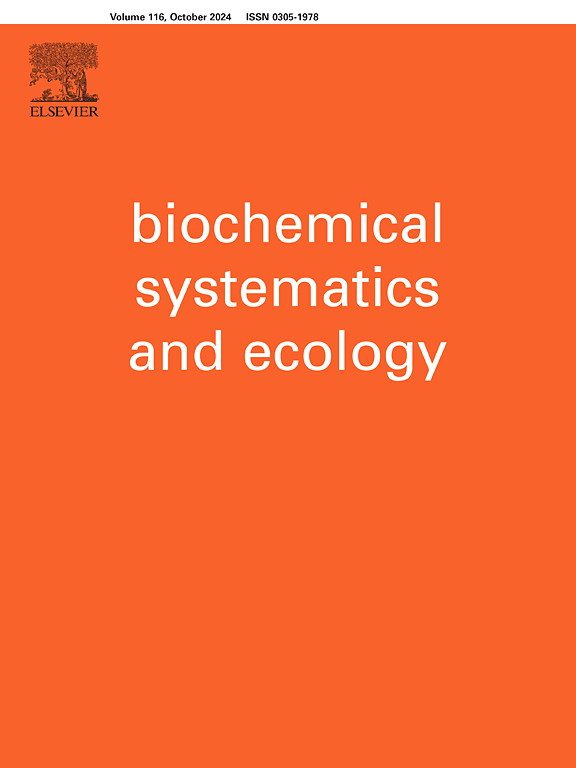A new seco-nortriterpene and other phytochemicals from Potentilla kleiniana and their chemotaxonomic significance
IF 1.4
4区 生物学
Q4 BIOCHEMISTRY & MOLECULAR BIOLOGY
引用次数: 0
Abstract
The chemical investigation of the Potentilla kleiniana led to the isolation of a new seco-nortriterpene, kleinianene (1), and eight known compounds including one phenylpropanoid glycoside (2), one lignan glycoside (3), one ellagic acid derivative (4), one phenylacetic acid derivative (5), one C21-steroid (6), one polyhydroxyalkylpyrazine derivative (7), one quinoline derivative (8), and one phenolic acid (9). Their structures were elucidated by extensive spectroscopic methods and comparison with literature data. Moreover, the anti-inflammatory activity of 1 was evaluated by measuring its inhibitory effect on NO production in LPS-stimulated RAW 264.7 macrophages. The obtained result showed a moderate inhibition effect of NO release with IC50 value of 26.88 ± 0.36 μM. All the above compounds were isolated from P. kleiniana for the first time and five compounds (2 and 5–8) were first reported from the family Rosaceae. Furthermore, the chemotaxonomic significance of the isolated compounds was discussed briefly.
一种新的北三萜和其他植物化学物质及其化学分类意义
对kleiniana Potentilla进行化学研究,分离出一种新的二北三萜kleinianene(1)和8个已知化合物,包括一种苯丙苷(2)、一种木脂素苷(3)、一种鞣花酸衍生物(4)、一种苯乙酸衍生物(5)、一种c21 -类固醇(6)、一种聚羟基烷基吡嗪衍生物(7)、一种喹啉衍生物(8)。和一个酚酸(9)。它们的结构通过广泛的光谱方法和与文献数据的比较得到了阐明。此外,通过测量其对lps刺激的RAW 264.7巨噬细胞NO生成的抑制作用来评估1的抗炎活性。结果表明,该方法对NO释放有中等抑制作用,IC50值为26.88±0.36 μM。上述化合物均为首次从该属植物中分离得到,其中化合物2和5 ~ 8为首次从蔷薇科植物中分离得到。并对分离化合物的化学分类意义进行了简要讨论。
本文章由计算机程序翻译,如有差异,请以英文原文为准。
求助全文
约1分钟内获得全文
求助全文
来源期刊

Biochemical Systematics and Ecology
生物-进化生物学
CiteScore
3.00
自引率
12.50%
发文量
147
审稿时长
43 days
期刊介绍:
Biochemical Systematics and Ecology is devoted to the publication of original papers and reviews, both submitted and invited, in two subject areas: I) the application of biochemistry to problems relating to systematic biology of organisms (biochemical systematics); II) the role of biochemistry in interactions between organisms or between an organism and its environment (biochemical ecology).
In the Biochemical Systematics subject area, comparative studies of the distribution of (secondary) metabolites within a wider taxon (e.g. genus or family) are welcome. Comparative studies, encompassing multiple accessions of each of the taxa within their distribution are particularly encouraged. Welcome are also studies combining classical chemosystematic studies (such as comparative HPLC-MS or GC-MS investigations) with (macro-) molecular phylogenetic studies. Studies that involve the comparative use of compounds to help differentiate among species such as adulterants or substitutes that illustrate the applied use of chemosystematics are welcome. In contrast, studies solely employing macromolecular phylogenetic techniques (gene sequences, RAPD studies etc.) will be considered out of scope. Discouraged are manuscripts that report known or new compounds from a single source taxon without addressing a systematic hypothesis. Also considered out of scope are studies using outdated and hard to reproduce macromolecular techniques such as RAPDs in combination with standard chemosystematic techniques such as GC-FID and GC-MS.
 求助内容:
求助内容: 应助结果提醒方式:
应助结果提醒方式:


